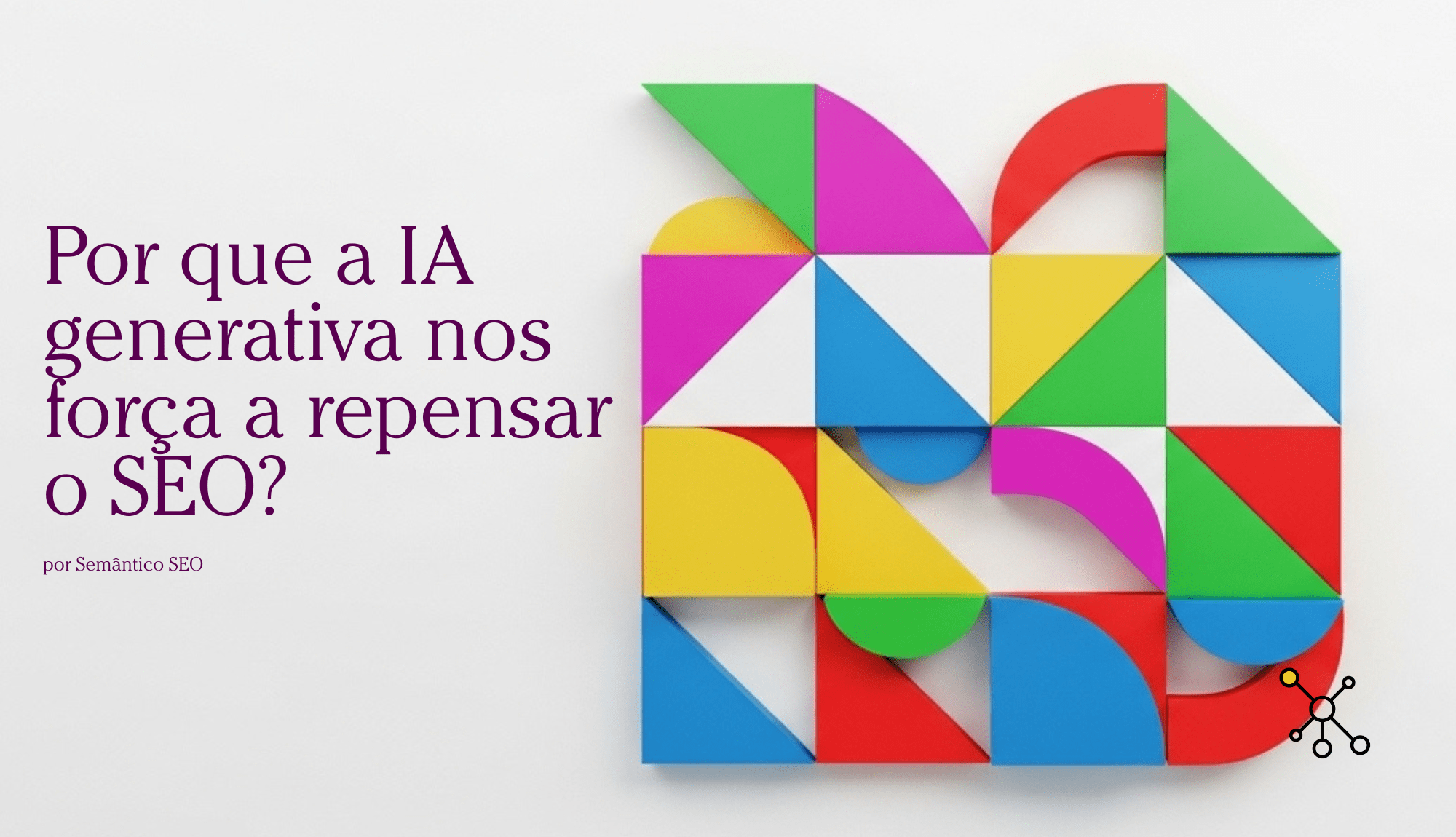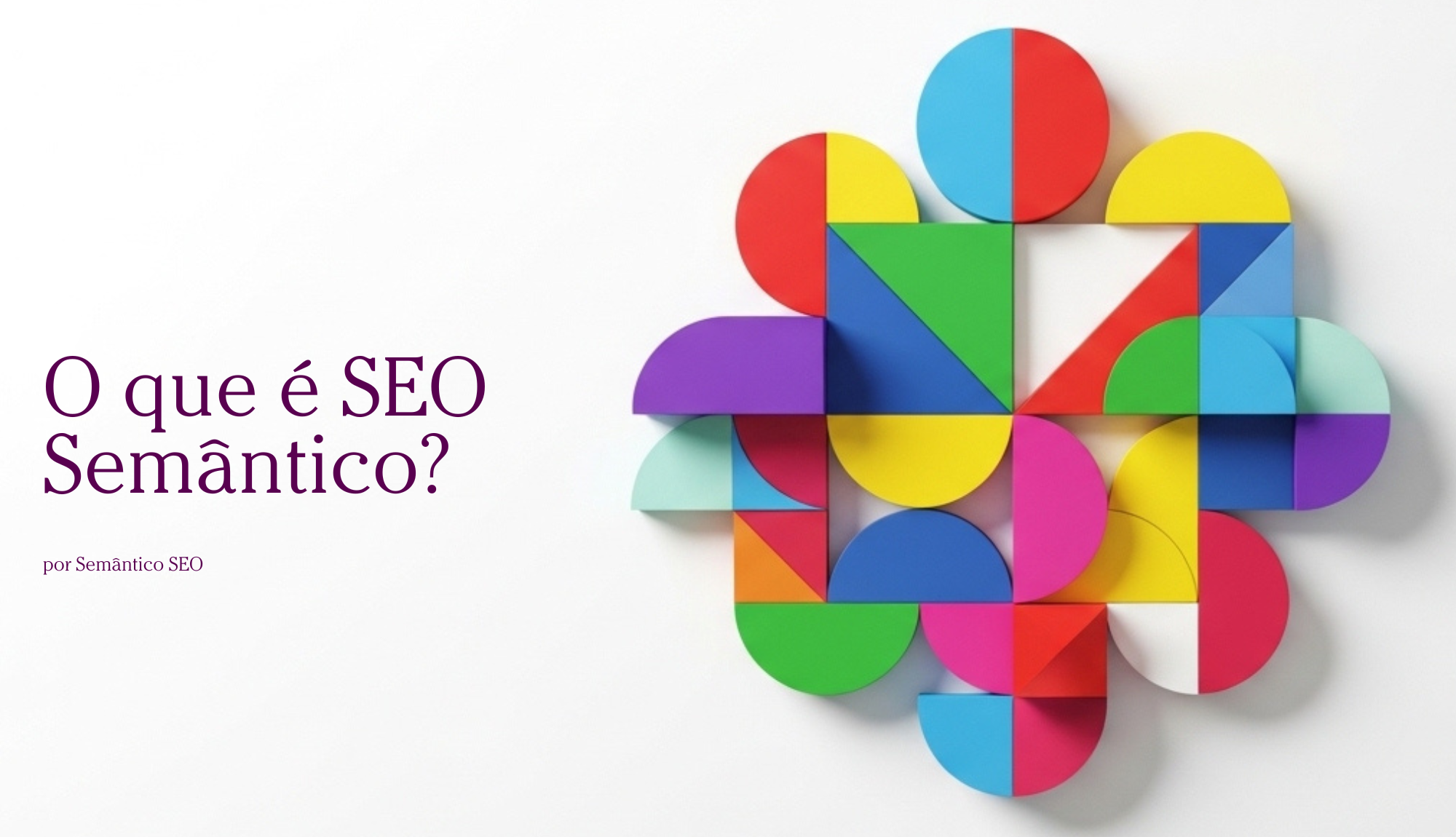Por que a IA generativa nos força a repensar o SEO?
Entramos na era das respostas e testemunhamos a morte das fontes. Neste artigo, vamos teorizar sobre as várias noções de busca, seus recursos e a avaliação à luz da IA generativa.
Vivemos um momento de inflexão na história da Web. A introdução em massa de modelos de linguagem de grande porte (LLMs), como o Gemini, e sua integração direta nos motores de busca desafiaram décadas de conceitos estabelecidos. Para nós, profissionais de SEO, a mudança é comparável a um terremoto. A forma como pensamos Busca, fontes e avaliação está sendo reescrita de forma fundamental.
O SEO mudou para sempre
Por anos, o mantra do SEO foi “criar conteúdo de qualidade” para que o Google nos considerasse uma fonte autoritativa e nos apresentasse ao usuário. Mas, como aponta um artigo recente de Olaf Sundon, professor de estudos da informação, surge uma pergunta fundamental: “O que acontece quando os sistemas de informação com IA fornecem cada vez mais respostas em vez de direcionar as pessoas às fontes?”
Antes eu te convido a assistir ao vídeo abaixo:
O vídeo analisa o artigo de conferência “Theorising Notions of Searching, (Re)Sources, & Evaluation in Light of Generative AI“, de Olaf Sundon, professor de estudos da informação. O objetivo principal do artigo é discutir os conceitos de busca, fontes e avaliação em uma infraestrutura de informação cada vez mais influenciada pela inteligência artificial generativa.
Uma distinção crucial é feita entre a busca por fontes (documentos que contêm informação) e a busca por respostas (fatos ou informações diretas). No artigo, Sundon utiliza uma abordagem sociomaterial, tratando a informação não como algo abstrato, mas como um participante ativo na construção do nosso mundo, citando exemplos históricos como os de Suzanne Brier e Paul Otlet. É apresentada uma história técnica das infraestruturas de busca, desde as bibliotecas antigas e os catálogos de fichas até os motores de busca da internet e suas evoluções.
Depois da leitura do artigo, que eu encontrei por conta do vídeo que convidei você a assistir, eu me fiz três perguntas:
- O que acontece quando os sistemas de informação com IA fornecem cada vez mais respostas em vez de direcionar as pessoas às fontes?
- A noção positivista de Otlet de extrair fatos abstratos de documentos (ou fontes de informação) pode ser comparada à tendência crescente de os sistemas de informação fornecerem respostas em vez de fontes?
- Como uma compreensão sociomaterial da informação pode nos ajudar a compreender a infraestrutura de informação cada vez mais infundida por IA a partir da perspectiva da Biblioteconomia e da Ciência da Informação?
Movido por esses questionamentos, inspirado por este artigo e pelo vídeo que o explica, procurei mergulhar de cabeça nessa questão.
Te convido a explorar a análise teórica de Sundon e conectá-la diretamente ao nosso trabalho de SEO Semântico. A infraestrutura da informação está mudando, e nossa capacidade de sermos encontrados depende de entendermos essa mudança.
Desde que existem sistemas de informação, bibliotecas e instituições similares para organizar informações, os princípios e métodos para apresentar e encontrar informações desempenham um papel fundamental. Existem bibliografias, listas, catálogos de fichas, índices de livros, OPACs, sistemas de classificação, tesauros com vocabulários controlados, portais da web, bases de dados bibliográficas, sistemas de gerenciamento de referências e assim por diante. Esses sistemas organizam e controlam o acesso às fontes de informação. Tecnologias novas e antigas frequentemente se fundem. Os mecanismos de busca na web dependem de seu índice, que contém apenas parte da web. Isso significa que, quando usamos a Pesquisa Google, estamos pesquisando em um índice, não na web online, e o tamanho e a atualidade do índice são critérios centrais de qualidade (Lewandowski, 2023, p. 41). Esses sistemas de informação sempre trazem consigo uma perspectiva particular, uma visão de mundo, seja a representação de tópicos em catálogos de bibliotecas (Olson,2002), mecanismos de busca na web (Lewandowski,2023, p. 265; Noble,2018) ou IA generativa (Sun et al.,2024).
SUNDIN, Olof. Theorising notions of searching, (re)sources and evaluation in the light of generative AI. Information Research: an international electronic journal, [S. l.], v. 30, p. 291-302, 2025. DOI: 10.47989/ir30CoLIS52258.
A tradição da recuperação da informação e a busca por fontes
Para entender a ruptura, precisamos primeiro solidificar o que ela rompe. A tradição predominante da Biblioteconomia e Ciência da Informação (LIS) e, por extensão, do SEO tradicional, sempre foi a de construir sistemas que fornecem ao usuário uma fonte de informação.
Como o artigo de Sundon e Hartel nos lembra, a história técnica da busca começa com bibliotecas e catálogos de fichas. Quando você ia a uma biblioteca, o bibliotecário (ou o catálogo) não lhe dava a “resposta”; ele lhe dava um livro, um documento ou um periódico. Ele o direcionava à fonte. A informação estava contida em um documento.
Os motores de busca da internet, em sua concepção original, seguiram exatamente este modelo.
Um mecanismo de busca como o Google era, e em grande parte ainda é, um sistema de recuperação de informação que rastreia, indexa e classifica documentos (páginas web). O trabalho de SEO consistia em garantir que nosso documento fosse considerado a fonte mais pertinente para uma consulta específica. O produto final era um link para uma página.
Havia uma distinção clara: a busca por fontes (documentos que contêm informação) e a busca por respostas (os fatos ou a informação direta). O trabalho do SEO era ser o melhor intermediário.
A mudança semântica: do link à resposta direta
Essa distinção começou a ficar turva muito antes da IA generativa. Como aponta o próprio artigo de Sundon, o Google iniciou uma mudança substancial em 2012. Essa mudança foi a introdução do Knowledge Graph (ou grafo do conhecimento).
Quer saber mais sobre os updates do algoritmo do Google?
O Google deixou de ser apenas um “indexador de páginas” para se tornar um “organizador de fatos”. Ele começou a transição de um motor de busca para um motor de respostas. Vimos, então, o nascimento do que hoje chamamos de SEO semântico.
Esta mudança tem raízes em ideias muito anteriores, como as de Paul Otlet, que sonhava com a extração de “fatos abstratos” de documentos para criar um “livro universal do conhecimento”. O Knowledge Graph do Google é a materialização digital dessa ideia positivista. Ele passou a exibir “respostas diretas”, como os Featured Snippets.
Desde então, o nosso trabalho como profissionais de SEO mudou. Foi nessa época que eu entendi que não bastava mais otimizar para palavras-chave. Depois de anos de tentativas e frustração eu entendi como estruturar os dados dos projetos, conectar suas entidades usando dados estruturados, mas só mais tarde conheci como usar taxonomias e ontologias nesse processo. Um dos objetivos passou a ser alimentar o Grafo do Conhecimento do Google com a minha informação. Nesse momento nasceu o Fluxo de Trabalho Semântico!
No entanto, mesmo nesse modelo, a fonte ainda era (geralmente) visível nas SERPs. O Featured Snippet continha um link. O Knowledge Panel citava fontes como a Wikipédia. Mas aí veio a IA generativa, que representa o ápice de uma mudança radical, e é aqui que a conexão com a fonte se rompe.
A ruptura generativa e as respostas sem fontes rastreáveis
O artigo de Olaf Sundon identifica com precisão a diferença entre um motor de busca tradicional e um aplicativo de LLM.
- Motores de busca tradicionais: fornecem links para documentos. São sistemas de recuperação.
- Chatbots de IA generativa: geram conteúdo. São sistemas de geração.
Shah e Bender (2022) observam que essa nova interação conversacional “tem o custo do acesso direto às fontes”. O resultado da IA generativa é “desprovido de conexões rastreáveis às fontes”. Isso está relacionado a como os modelos foram construídos ou, ainda mais, a como o Transformer funciona.
Isso é o que Bender et al. (2021) chamaram de “papagaio estocástico”, um termo que ficou muito conhecido. Como explicado no vídeo de Hartel, o LLM não “entende” o significado no sentido humano. Ele é um modelo estatístico treinado para gerar “sequências de palavras com sonoridade plausível” com base nos padrões observados em seus dados de treinamento.
O resultado parece coerente, mas não possui significado real nem uma conexão verificável com uma fonte estável. Para a Ciência da Informação, isso é uma “ruptura significativa”. Para o SEO, é um pesadelo de atribuição.
A crise da avaliação
Como confiar em um papagaio?

O argumento principal do artigo de Sundon é que, com essa mudança, “as fontes estão se tornando cada vez mais invisíveis”. Isso nos leva ao próximo pilar que desmoronou: a avaliação.
A alfabetização informacional tradicional, como o método SIFT (Stop, Investigate the source, Find better coverage, Trace claims), baseia-se inteiramente na capacidade de investigar a fonte.
Quando lidamos com a informação recuperada, nós perguntamos:
- Quem é o autor?
- Qual é a reputação desta publicação?
- Qual é a data da publicação?
- Quais são as fontes deles?
Como aponta o artigo que deu origem à minha investigação, a ascensão da IA generativa torna essa avaliação tradicional “quase impossível”. Quando um LLM gera uma resposta, não há autor. Não há data de publicação. Não há “origem da fonte” além do próprio modelo.
Desde que Sundon escreveu o seu texto até hoje, algumas mudanças foram feitas pelo Google, principalmente. Agora temos, na maioria das vezes (limitado aos modos AI Overview e Modo IA), a citação das fontes, mas de forma descontextualizada, já que não sabemos exatamente qual parte do texto de cada fonte foi responsável pela geração por IA.
O usuário recebe um texto que soa plausível, mas pode ser uma “alucinação”: uma colagem estatística de fatos descontextualizados, factualmente incorretos, mas que parecem verdade. O problema é que, sem uma fonte para rastrear, o usuário não tem como saber.
Isso tem implicações profundas para estudantes, pesquisadores e, claro, para o público em geral. Como podemos navegar teoricamente neste cenário? A resposta, para mim, está em dobrar a aposta nos princípios do SEO Semântico.
O papel do SEO semântico na recuperação da informação na era generativa
Se a IA generativa é o novo intermediário, como nós, criadores de conteúdo e proprietários de sites, garantimos que nossa informação seja encontrada e, esperançosamente, creditada?
A resposta não está em tentar “enganar” o LLM. Ou requentar estratégias antigas, mas sim em tornar nosso conteúdo a fonte de dados mais limpa, estruturada e semanticamente rica possível para o treinamento e a indexação desses modelos.
É aqui que a Recuperação da Informação encontra o SEO Semântico.
Quando falo em SEO semântico, estou falando sobre focar no sentido, estruturar a informação e moldar o conteúdo de modo que os algoritmos possam entendê-lo conceitualmente. Estou falando de aplicar um modelo de trabalho semântico desde o início até o fim.
Esta é a nova realidade. O SEO se tornou infinitamente mais complexo. A SERP, composta por um “ranking” de links, está morrendo lentamente, e nós estamos otimizando para sermos a fonte de fatos mais confiável e semanticamente compreensível para os algoritmos que alimentam os modelos de IA.
Sinto muito se lhe deixei ansioso. Afinal de contas, como fazer isso?
É para isso que estou criando o Curso de SEO Semântico – O Fluxo de Trabalho Semântico. Eu te convido a me seguir no LinkedIn; por lá vou atualizando sobre o lançamento dele.
A responsabilidade da fonte na nova Web Semântica
O artigo de Olaf Sundon e a análise de Jenna Hartel são um alerta determinante para a comunidade de Ciência da Informação. Mas eu argumento que é um alerta ainda mais urgente para nós, profissionais de SEO.
Estamos entrando em uma era em que a informação é divorciada de sua origem. A consequência disso é a erosão da confiança. Se um LLM me der uma resposta errada, a quem eu culpo? Como eu corrijo? A “caixa preta” do “papagaio estocástico” está herméticamente fechada.
O artigo de Sundon termina com uma observação essencial: “Não dar as fontes das nossas afirmações era complicado antes, mas conseguíamos fazer o caminho inverso e chegar à fonte. Hoje, com a generativa, nem sempre é possível. Então, todo mundo que tem compromisso com a informação de qualidade precisa fornecer as fontes das suas afirmações.”
Como profissionais de SEO, nosso papel evoluiu de “construtores de links” para “arquitetos da informação”. Agora, devemos nos tornar “curadores do conhecimento”.
Nosso trabalho não é apenas fazer o Google encontrar nosso site; é garantir que a IA tenha acesso a fatos verificáveis e estruturados. E, mais importante que tudo, devemos advogar e construir sistemas que exponham suas fontes, que recompensem a transparência e que permitam ao usuário fazer o que a Biblioteconomia e a Ciência da Informação sempre defenderam: avaliar a fonte da informação.





Publicar comentário